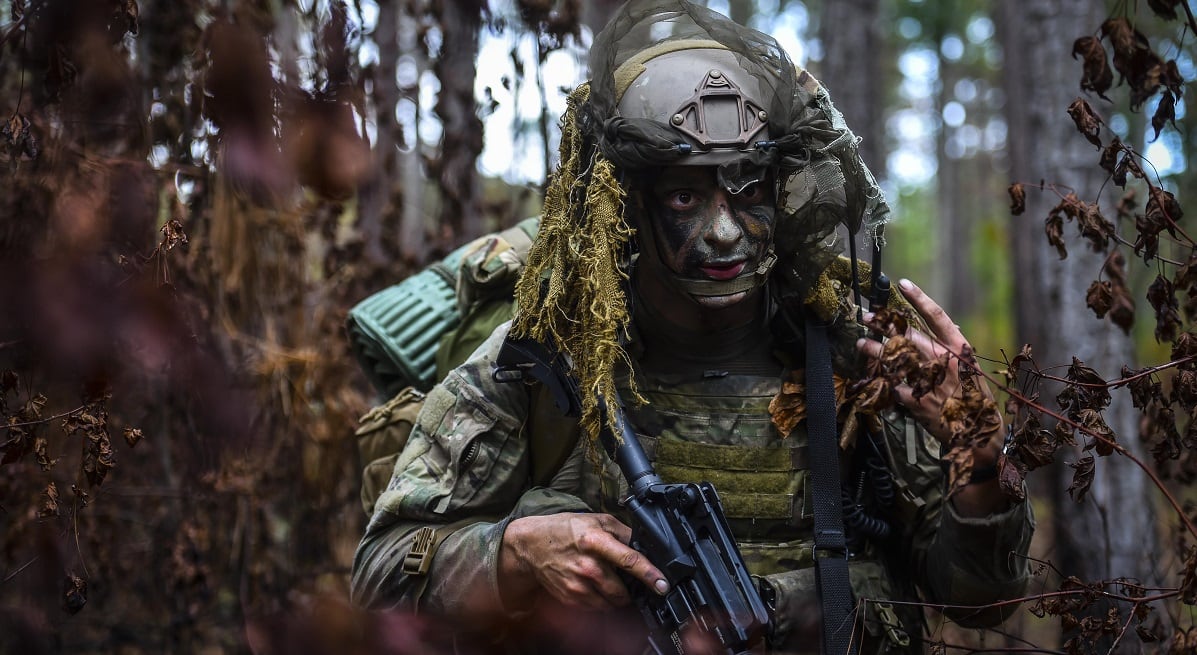The Air Force stood up a new wing last week, aiming to improve how it creates its elite special warfare airmen. Service leaders want to emphasize their common capabilities instead of their specializations earlier in the training process.
“Whether you’re attaching to the joint force to provide your specialized skills, or working as teams of airmen to execute air power-related missions, we get the most value by building that common foundation first, and then specializing later based on that operational need,” said Col. James Hughes, commander of the new Special Warfare Training Wing at Joint Base San Antonio-Randolph, in an Oct. 12 interview.
The Air Force hopes the new wing, activated Oct. 10, will also result in increased retention of special warfare airmen, who were previously referred to as battlefield airmen.
The wing is planning to combine the various courses of initial entry for all special warfare candidates into one combined course. This will help build a “team mentality” between airmen from the seven special warfare career fields, both to focus on their similarities and improve efficiency.
RELATED

This means a trainee who comes in today will hear less about his particular specialty up-front, and spend time learning the common skills that apply to all special warfare airmen. Those common special operations skills include infiltration, exfiltration, and how they move, shoot and communicate, Hughes said, as well as how to survive and operate on the ground.
“We’re focused on accentuating what our various ground specialties have in common, and consolidating our training around the common core of ground combat, and then specializing from there," Hughes said. "In the past, we were focused on specialization up front.”
For example, today aspiring combat controllers, pararescuemen or tactical air control party airmen go through their respective apprentice courses to earn their entry-level qualification. Each of those courses teaches land navigation, basic weapons handling, and basic ground tactics.
That isn’t very efficient, Hughes said, and consolidating all that training would help the airmen by training them on a common standard.
But the wing hasn’t yet made that shift. Hughes said it’s exploring several options for how to combine those training programs into a common assessment and selection course after the battlefield airmen preparatory course. Trainees would then move into more specialized, follow-on training.
The shift would also mean trainees would begin to think of themselves as special warfare airmen first, and then focus on thinking about what it means to be a pararescueman or combat controller.
“There is more value in building a common foundation for ground combat, and then allowing the specialization to come based on the operational need that’s out there," Hughes said. "We still envision providing highly specialized airmen to joint teams to provide specific air power-related capabilities, as we always have done. But also as we see, expanding in the future, teams of airmen going out to conduct missions such as global access, precision strike, personnel recovery, those types of missions that our teams train and prepare to go execute in support of the joint force.”
Special warfare airmen also include combat rescue officers, special tactics officers, special operations weather team airmen, and non-rated air liaison officers.
The new wing will have about 135 personnel. Air Education and Training Command’s Battlefield Airman Training Group, which was created in June 2016, will be renamed the Special Warfare Training Group and be folded into the wing.
In an Oct. 12 interview, Hughes said that the training group became strained as the demand for special warfare airmen and their requirements grew in recent years.
Besides continuing the training group’s previous focus on marketing and recruiting, manpower and leadership, curriculum, and equipment and infrastructure, the wing will focus on using cutting-edge science and technology to improve airmen’s physical and mental performance. The wing’s new Human Performance Support Group will combine specialists from various sports and medical fields to improve how airmen perform, as well as reduce their injuries and speed up their rehabilitation.
“By pushing the limits of science and technology, we’re going to find the most efficient and effective methods for improving human performance,” Hughes said. “We’re going to take what we already have learned and enhance how we produce the most physically and psychologically fit airmen possible for the joint force.”
Hughes said the shift will take some wing-level responsibilities — such as managing finances, personnel, facilities and infrastructure — off of the group, allowing it to focus solely on training. And the wing will handle communication with higher headquarters and other external agencies, so the group doesn’t have to.
The wing is in close contact with the newly activated 330th Recruiting Squadron, which is part of the Air Force Recruiting Service, Hughes said. This allows the training wing to stay in contact with a recruit from the first time he expresses interest in becoming a special warfare airman.
Stephen Losey is the air warfare reporter for Defense News. He previously covered leadership and personnel issues at Air Force Times, and the Pentagon, special operations and air warfare at Military.com. He has traveled to the Middle East to cover U.S. Air Force operations.




